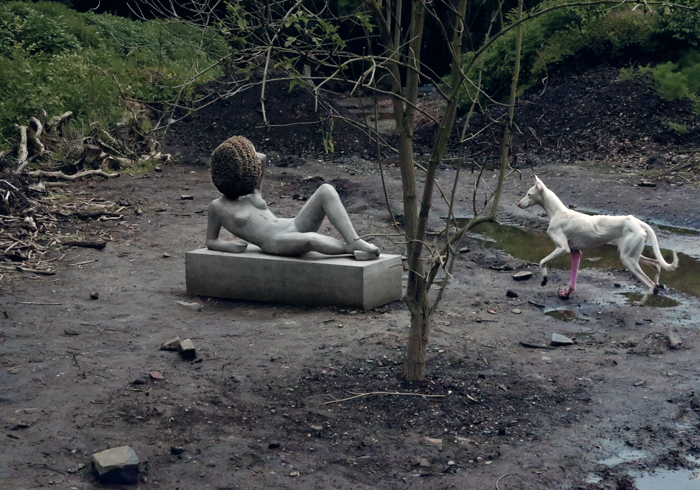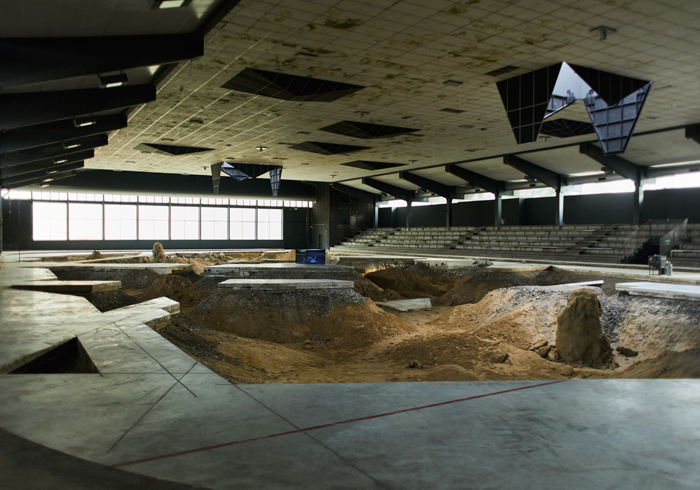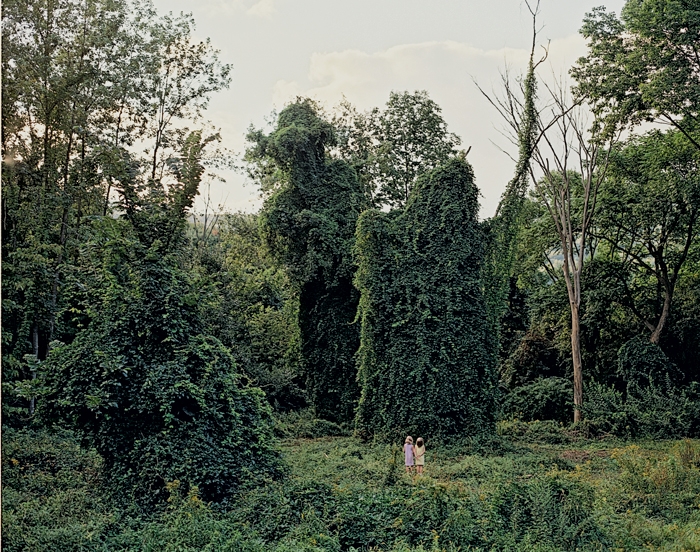Unknowability is hardwired into the world. Chaos theory tells us that the complex systems shaping our experience of the world cannot perfectly be predicted; recent financial and ecological crises have provided ample proof of humanity’s hubris in presuming otherwise. It is impossible to know, when the butterfly flaps its wings in Brazil, whether or not a tornado will ensue in Texas, and so, while the gap between what should and what will happen may be infinitesimally narrow, it remains unbridgeable to anything but God. Pierre Huyghe creates situations in which these conditions operate on a smaller scale, alerting us to the fact that we can never fully grasp the world or know what the future holds.
During a 30-year career the artist has created a body of work encompassing environmental installations ranging in scope from domestic aquaria to abandoned ice rinks, the documentation and reenactment of a research trip to Antarctica, innumerable works in diverse media playing on the themes of memory and identity, and open-ended collaborations between human and nonhuman intelligences such as the masked monkey pottering around what appears to be the Fukushima Exclusion Zone in the 2014 film Human Mask. In each of these the artist-as-creator is figured as something between watchmaker and gardener, creating systems and setting in motion their constituent parts without intervening to dictate their behaviour. He describes his position in relation to the work as being “upstream” from it; his role is, he tells me by email, to “conceive the conditions” in which things happen “rather than trying to invent for the sake of it”. He builds worlds and watches them play out.
I remember entering one of them on a sunny afternoon six years ago. A friend and I were walking through a field of wildflowers on the outskirts of Kassel, past a heap of stone debris and stacks of concrete slabs, when we came upon a clearing charged with the warm buzz of bees. Beside an uprooted oak tree was a cast-concrete sculpture of a reclining female nude with an ovoid honeycomb hive for a head – source of the hum – past which trotted an elegant white greyhound with a pink-painted foreleg. We knew that these diverse elements constituted an installation by Huyghe for Documenta 13 with the double-take title Untilled (2011–12), but there was little way of knowing where the artwork ended and the outside world began.
The dissolution of boundaries between reality and representation has characterised Huyghe’s practice from the start. For Chantier Barbès-Rochechouart (1994), one of a series of billboard projects, Huyghe photographed actors posing as labourers at a construction site. The image was then posted onto a hoarding overlooking the location so that the real workers, when they returned to the site, were confronted by their own reconstructed selves. Remake (1994–95) restages Alfred Hitchcock’s Rear Window (1954) using amateur actors; for No Ghost Just a Shell (1999–2002) Huyghe and Philippe Parreno purchased an off-the-shelf manga character named Ann Lee and loaned her out to artists including Dominique Gonzalez-Foerster and Liam Gillick. The equally slippery A Journey that wasn’t (2005) started with Huyghe embarking on an expedition to the Antarctic in speculative pursuit of an albino penguin, an evolutionary detour of the artist’s own invention, and ended with a hulking mechanical version of the animal clambering across the ice rink in New York’s Central Park during an operatic production based on the journey. Huyghe told the art historian George Baker in a 2004 interview that ‘we should invent reality before filming it’, and these works go beyond the mere confusion of fact and fiction to question how our experience of the world is constructed.

Back in 2012, my friend and I struggled through a thicket of brambles in pursuit of the pink-legged dog (named, we later discovered, Human) and found ourselves lost in a forest. Or at least that’s how I remember it. My memory of that day is suspect, the mental images no doubt corrupted by others that accumulated in the intervening years, and the harder I try to pick out details, the less reliable it seems. Was it really beside the hive that we encountered the dog, or did I see that in a press photograph? Huyghe’s unsettling two-channel video The Third Memory (2000) addresses the entanglement of personal and historical memory by reenacting the bank heist that inspired Sidney Lumet’s Dog Day Afternoon (1975). In doing so, the artist shows how the original protagonist’s own recollections of the day have been distorted by the Hollywood film. Our minds are fallible and our memories fickle, which has troubling implications for the individual identity that each of us carries confidently around with us. I’ve often cited that encounter with Huyghe’s work at Documenta as a formative one, and yet the attempt to reconstruct my subjective experience of the day only estranges me from it.
The gulf separating our subjective experiences from our reconstructions of them – as well as the gaps separating then from now, here from there, cause from effect – is addressed by Huyghe’s latest exhibition at London’s Serpentine Galleries. On large-format LED screens will flicker a series of digitally reconstructed images (I’ve seen them in excerpts supplied by the studio), produced through a combination of human and artificial intelligences, depicting monstrous, shapeshifting creatures. These are the fruits of an unusual process: first, the artist thought up a situation – a “new world”, he tells me, in which “animal, human and sentient machines share a common imaginary feature” – and asked someone else to imagine it. Their interpretation was then transformed by a deep neural network (an information-processing model based loosely on the human nervous system) into these nightmarish mutants, which are further modified by external factors including light, temperature and humidity levels in the gallery, and the behaviour of visitors within it. As the honeycomb bee-brain of the concrete sculpture I saw in Kassel operates as a literal and figurative partnership with animals (and a model for an alternative society), so this new work opens up a space in which human and artificial intelligences coexist and collaborate.

The presence of what seem to me configurations of lips, eyes and mouths in these blurred and distorted images is also a collaborative effort: a result of the way the network was trained to recognise images, the prompt given to the thinker and the viewer’s own inherent pareidolia (meaning that the viewer contributes to the production of meaning not only by assisting unwittingly in the images’ composition but via their own interpretive predispositions). The shifting tempos contribute to a prevailing atmosphere of temporal instability: the incubation, birth and death of thousands of flies introduced to the Serpentine’s central gallery describes, according to Huyghe, “a nonregular cycle, variations avoiding linearity”. These works do not observe conventional narrative arcs and belong neither in the fleeting moment of the performance nor the quasi-eternal of the traditional art object; rather they are caught up in rhythms more closely resembling those that govern the natural world. Always changing and always the same.
Those competing time scales and signatures were apparent in Huyghe’s contribution (After ALife Ahead, 2017) to the most recent edition of Skulptur Projekte Münster, situated in an abandoned ice rink populated by a venomous sea snail, peacocks, algae, bees, an incubator for cancerous cells and innumerable po-faced members of the artworld trying to give the impression they knew what was going on. That the experience of immersion in this ecosystem was bewildering is part of the point: as the artist relinquishes a degree of control over the scenarios he has created, so the viewer is encouraged to give up any illusion of fully understanding her place within and influence upon them.
Huyghe describes his mission in making A Journey that wasn’t as being to produce a “no knowledge zone”. The work questions whether it is ever possible to bring something back from another place, whether that something might be an albino penguin or a fading memory. The subjective experience of other participants in the world – whether a different species, a rock or an artificial intelligence – can never be properly reconstructed in the human mind, as Thomas Nagel’s celebrated essay ‘What Is It Like to Be a Bat?’ (1974) made clear. Our felt experience of the world is determined by our predisposition towards particular carriers of significance within it, and so we can’t imagine ‘seeing’ the world through echolocation, nor could we understand a lion even if it were able to speak. It’s not only the experience of different species that is configured differently. In his autobiography Speak, Memory (1951), Vladimir Nabokov, entering a meadow in pursuit of butterflies, asked a passerby whether he had seen any. The passerby had seen none, and so Nabokov was astonished moments later to find the field swarming with them. Lepidopterists like Nabokov have trained themselves to see them everywhere. Every experience of the world – of an artwork – is particular to the feeling subject and their unique perspective on it.

The anecdote brings to mind the 10,000 ants and 50 spiders set free in Esther Schipper’s Berlin gallery as part of Huyghe’s Umwelt (2011). Over the course of the show the different species conformed to their expected behavioural patterns (the ants formed trails across the space, the spiders retreated in solitude to its corners), but the title – which refers to Jakob von Uexküll’s description of the idiosyncratic world that each person perceives around them – warns against the assumption that we can in the fullest sense understand such behaviours. We might know that most spiders are conditioned by evolution to seek out solitude, but we can never know how that solitude feels to a spider. Like reading Maurice Maeterlinck’s famous The Life of the Bee (1901), which describes the mind-bending architectural genius and social intelligence of the endangered insect, simply observing the behaviour of these species provokes a sense of awe beside the realisation of how little we understand.
That other species and cultures must remain unknowable is not, in Huyghe’s work, an admission of defeat so much as an acknowledgement of difference and a warning against the belief that we can systematise, taxonomise and thus exercise control over them. This strikes me as a political principle, and the artist tells me that he aims to produce “new conditions” that can “decentre and weaken power structures”, chief among which is the assumption of a rational and coherent self that is the most fantastic (and, arguably, damaging) of all the stories that humans tell themselves in order to live. There is nothing more ignorant than to assume that one knows or is capable of knowing everything, and so Huyghe provokes the puzzlement and indeed wonder that stimulates the creative imagination and is at the root of all intellectual endeavour. Which is to say – and I wish my friend and I had remembered this on having got lost in the forest that day – that in order to find new ways out, you have first to admit that you’re lost.
A solo exhibition of work by Pierre Huyghe is on view at the Serpentine Galleries, London, through 10 February
From the October 2018 issue of ArtReview
